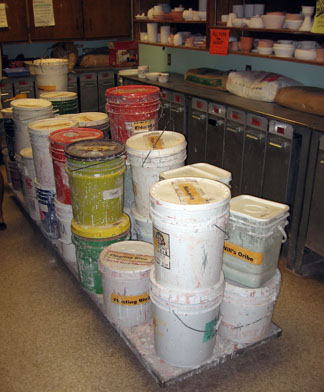 The other day a new ACC member was ready to glaze, and he faced a dizzying glut of options, all of which were new to him. It looked something like this:
The other day a new ACC member was ready to glaze, and he faced a dizzying glut of options, all of which were new to him. It looked something like this:Daunting, I know. The first thing to know about glazes is that they're not paint. Underglazes, popular with paint-a-pot places like DoArt and The Studio, are the thing to use if you want what-you-see-is-what-you-get color and a glaze that won't run or combine with other glazes in surprising ways.
True glazes are much less predictable. They're made up of three basic ingredients: silica, or glass; modifiers, which adjust when the glaze will melt; and chemicals that give the pot color.
They can be applied in many ways, the most popular of which is airbrushing, because it covers the pot evenly and allows two glazes to blend nicely. Other options are dipping, brushing and pouring.
Some hazards of glazing, of which there are many: If the glaze is too thick, it will crawl. Sometimes this is the desired effect, as in this photo of a crawl glaze. But if it's not your intention, you'll be disappointed when your glaze is bumpy and not food safe. Before firing your glazed pot, you must make sure that you've dry footed (I like to think of this as wiping the pot's bottom, like you would a baby). Your pot should be glaze-free anywhere it will touch the kiln shelf, and you should leave a little extra room above where it meets the kiln shelf to protect yourself from runny glazes. If you don't do this, your pot and the kiln shelf will be joined for all eternity. Another hazard: ugly glaze combinations. Don't couple two of your favorite glazes on a favorite pot. You never know how they'll turn out. This is where your studio community will come in, with popular, well-tried glaze combos. Some of the favorites in our studio are Seafoam over Plum Base, White over Ebony and Lydia Yellow over Floating Blue. If you're trying something new, be sure to try it on a test tile.
Finally, to show how different the glaze is before firing and after, I have some photos for you. Nothing like paint!



No comments:
Post a Comment